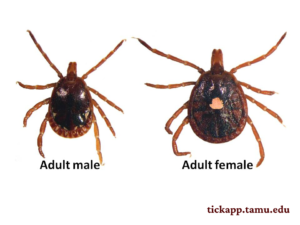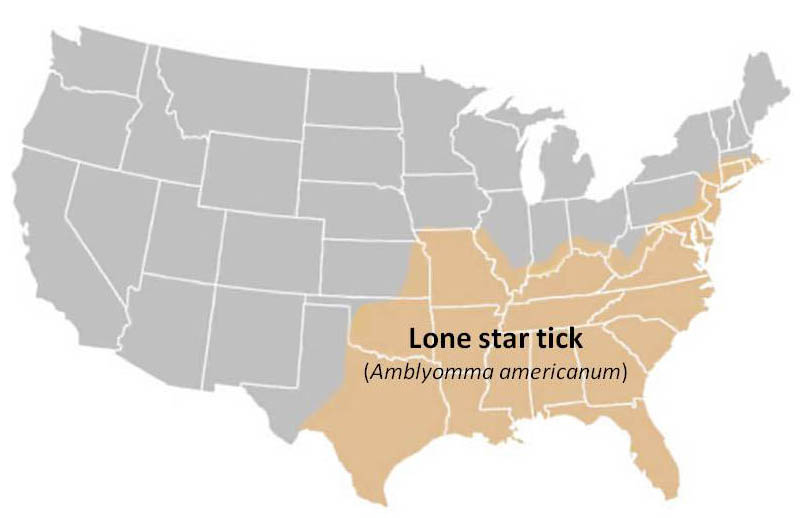Species: Amblyomma americanum Linnaeus
Family: Ixodidae (Acari)

Description: Adult females are reddish-brown in color and can be readily distinguished from other ticks by the presence of a single, solitary spot atop the center of the back which is often iridescent and may vary in color from white to cream, or gold to bronze. Among ixodid ticks (or “hard ticks”), females are generally larger than males. Lone star tick females average 4-6 mm unfed, and up to 16 mm or larger once fully fed. Size among lone star tick males averages 2-5 mm regardless of feeding state. Scutum coloration in males is dark brown, sometimes with patches of red. Cream colored or whitish ornations are usually present along the posterior dorsal margins of the scutum and festoons of adult males.

Distribution: The lone star tick is common to the Southeastern quarter of the U.S., ranging along the eastern seaboard with over-wintering populations established as far north as coastal Maine in recent years.
Hosts: Lone star ticks are generalist feeders at all three lifestages. Larvae and nymphs feed on small mammals and ground-frequenting birds in addition to white-tailed deer and cattle. Adult ticks parasistize deer, cattle, horses, feral swine, sheep, dogs, and humans.
Biology: The lone star tick is a 3-host tick which is capable of producing a generation (larvae, nymph, and egg laying adult females) per year and exhibit distinct seasonal activity patterns by lifestage. Adults may overwinter, becoming active January-February and peaking March-May. Nymphs have two primary activity periods, April-June for overwintering ticks and July-August for current year progeny. Peak activity of larvae generally occurs June-August, but may vary due to seasonal climatic and geographic influences.
Associated Disease Pathogens: The lone star tick is recognized by the Centers for Disease Control (CDC) as the principal vector of Ehrlichia chaffeensis and Ehrlichia ewingii in the U.S.; both disease agents are responsible for causing ehrlichiosis in humans. White-tailed deer are a primary host of the lone star tick and appear to serve as a natural reservoir for E. chaffeensis. The lone star tick also transmits STARI (Southern Tick Associated Rash Infection) to humans, a bacterial infection which symptoms may include the presence of a rash that appears similar to the “bullseye” rash seen in some Lyme Disease cases.
